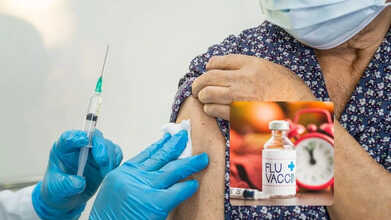- Health Conditions A-Z
- Health & Wellness
- Nutrition
- Fitness
- Health News
- Ayurveda
- Videos
- Medicine A-Z
- Parenting
- Web Stories
Colon Cancer Is Rising In Millennials- But This One Symptom Still Feels Too Embarrassing To Talk About

Credits: Canva
Colorectal cancer, once considered a condition affecting primarily those over the age of 50, is no longer limited to aging adults. The disease is increasingly affecting younger adults—millennials and even members of Gen Z. A report by American Cancer Society reveals that every generation of people born after 1950 is experiencing a higher risk of colorectal cancer, a trend that has left researchers and medical professionals stunned.
The disease, which includes both colon and rectal cancers, is growing most rapidly in adults 20 to 39 years old, with a 2% average annual rate of increase in incidence since the mid-1990s. This epidemiologic transition is causing legitimate public health alarms—and at the core of the crisis is an alarming fact: the most likely symptom of colon cancer is one that many will be too ashamed to discuss.
Colon Cancer: One Symptom That Should Never Be Ignored
In a 2024 study by Joshua Demb, assistant professor and researcher of early-onset colon cancer at the University of California, San Diego, rectal bleeding was the most specific and common early symptom in young adults with colorectal cancer. And yet, it's the one that many people—particularly millennials—are least likely to mention.
Through his interviews with patients, Demb discovered a shared pattern- patients held off on coming in for care because they were embarrassed to discuss "poop" or blood in their stool. This resistance is not anecdotal alone—it is a deeper cultural taboo dating back centuries, especially in Western cultures where bathroom behavior has always been tainted by shame.
Also Read: India Records 3,395 Active COVID-19 Cases, 26 Deaths, Kerala And Maharashtra Among Worst-Hit States
Blowing off blood in the toilet or denying pencil-thin stools as benign gastrointestinal problems might cost lives. "When young adults finally come forward, their cancer has usually advanced beyond it should have," Demb said. "Shame about bowel movements can add to delay in diagnosis in a disease where timing is everything."
Colon Cancer: Why Young People Are at Greater Risk?
Although colorectal cancer is still a slow-growing cancer, specialists caution that its increase among young adults may be the result of both genetic susceptibility and lifestyle choices.
Dietary patterns including high consumption of red and processed meats, low fiber intake, physical inactivity, increased prevalence of obesity, and higher alcohol and tobacco consumption are all potential drivers of this trend. The World Cancer Research Fund suggests aiming for less than 18 oz per week of red meat and focusing on a high-fiber, plant-based diet to lower the risk of colorectal cancer.
"We're observing increasingly urbanized, digitally connected young patients with rapid food intake, extended sitting times, and minimal physical activity," says Dr. Maria Ellis, an oncologist who specializes in gastrointestinal cancers. "These habits likely lead to inflammation and alterations in the gut microbiome, all conducive to the initiation of early tumors."
Also Read: How “Safe” Vaping Is Hooking A New Generation On Nicotine?
The Challenges with Current Screening Guidelines
One of the largest updates to solving this health crisis is screening age eligibility. Routine colonoscopies are suggested beginning at age 45 to 50 in most countries, including the U.S. But if the demographic that is growing quickest is under 40, this model is already outdated.
Even when young adults come with typical presentations—chronic abdominal pain, change in bowel habits, or bleeding per rectum—the suspicion of cancer is usually ignored by patients and doctors. Colonoscopies are painful, costly (several thousand dollars without insurance), and seldom prescribed for individuals in their twenties or early thirties unless there is a family history.
"There's still a lingering thought among primary care doctors that cancer is an 'older person's disease,'" says Dr. Ellis. "That results in young patients being misdiagnosed with hemorrhoids, irritable bowel syndrome, or anxiety-related gastrointestinal issues."
Colon Cancer: Psychological Burden on Young Adults
For young adults and adolescents (AYA), a cancer diagnosis disrupts not only health, but also identity, education, relationships, and planning for the future. A 2025 study presented at the American Society of Clinical Oncology (ASCO) identified four core areas of support lacking in AYA cancer treatment: academic accommodations, loss of extracurricular activities, disruption of career trajectory, and loss of peer affiliation.
This age group is typically just starting out in their adult lives—beginning careers, dating, or establishing families. Stigma of "poop talk" creates another layer of loneliness and humiliation, compounding the delay in diagnosis and treatment.
How to Identify a Red Flag in Colon Cancer?
Many of the initial symptoms of colon cancer will look like other diseases like celiac disease, irritable bowel syndrome, or hemorrhoids. But the most important clue to look for is a change from your usual pattern of digestion. If your bowels suddenly change—and remain changed—it's time to see a doctor.
Other signs include:
- Rectal bleeding
- Unexplained abdominal pain
- Chronic diarrhea or constipation
- Pencil-thin stools
- Fatigue or unexpected weight loss
Young adults should not be afraid to speak up for themselves in doctor's offices, even when they do not have a family history of cancer. A second opinion, particularly in the case of a persistent symptom, can be the difference between life and death.
Why Talking About Stool Could Be Life-Saving?
The cultural shame of defecation runs deep—but it's time to break it. Public health initiatives need to incorporate plain language that de-stigmatizes important bodily functions. As Dr. Demb says, "Normalizing conversations about poop isn't just cute or quirky—it's a serious tool in cancer prevention."
Parents, teachers, influencers, and physicians need to all join together in promoting a culture that favors openness regarding gut health. Vocabulary such as "stool" or "rectal bleeding" should not be masked in euphemisms. Millennials, the group that has spearheaded mental health activism and sexual health education, are perfectly placed to help break down this barrier.
Millennials are confronted with an unprecedented health threat that calls for urgency, awareness, and action. Early-onset colon cancer is not only a health problem—it's a cultural one, driven by stigma, misinformation, and outdated screening practices.
Fact Check: Does Cracking Your Knuckles Every Day Damage Your Joints?

Credits: Canva
If you are someone who cracks your knuckles every day just for that oddly satisfying pop, you are not alone. For many, the sharp sound brings a fleeting sense of relief or relaxation. Yet, there has long been a debate about whether this seemingly harmless habit could actually damage your joints or raise the risk of arthritis.
For those unversed, the pop you hear when cracking your knuckles comes from gas bubbles in the joint fluid collapsing. For most people, it’s harmless, though it can occasionally cause slight swelling or a temporary drop in grip strength. The long-standing belief that it leads to arthritis is not backed by science, but using too much force could result in minor injuries, like ligament sprains or dislocations
Addressing this common worry, orthopedic surgeon Dr. Manan Vora answered the question in a viral reel that has now surpassed 2.5 million views. A viewer asked him, “Can cracking knuckles every day lead to arthritis?”
Dr. Vora said, “The pop you hear when cracking a knuckle is the sound of these bubbles bursting within the synovial fluid inside the joint,” he clarified.
Is Cracking Knuckles Bad For You?
Knuckle cracking is a habit many pick up early in life, often because they enjoy the sound or the temporary feeling of looseness in the fingers. According to the Johns Hopkins Arthritis Center, the sound comes from changes inside the joint capsule, which is filled with synovial fluid. This fluid not only lubricates the joints but also nourishes the surrounding bones.
“A variety of gases are dissolved in this fluid. When a knuckle is cracked, stretching the capsule lowers the pressure inside, creating a vacuum. The dissolved gases form a bubble, which bursts, producing the familiar popping sound. It takes time for the gases to re-dissolve, which is why you can’t immediately crack the same knuckle again,” Johns Hopkins adds.
Does Cracking Knuckles Cause Arthritis?
Many worry that frequent knuckle cracking could trigger arthritis. However, research shows there is no evidence linking the habit to arthritis or long-term joint damage. A few reports have noted that excessive cracking may occasionally cause minor ligament strains or tendon dislocations, but these injuries typically heal on their own.
Some studies also suggest that habitual knuckle crackers might have slightly reduced grip strength over time, but this does not equate to arthritis. Rarely, “knuckle pads” can develop in young people who crack their knuckles often, but these are mostly cosmetic.
Several studies back up the conclusion that knuckle cracking does not cause arthritis. For example, a study by the Uniformed Services University of the Health Sciences followed 215 participants, 20% of whom regularly cracked their knuckles. They found arthritis in 18.1% of knuckle crackers and 21.5% of non-crackers, essentially the same rate, showing no link between the habit and the disease.
A famous anecdote comes from Dr. Donald Unger, who cracked the knuckles on his left hand twice daily for 50 years while leaving his right hand untouched. Published in Arthritis and Rheumatism in 1998, the informal experiment revealed that neither hand showed signs of arthritis. More recent studies in 2017 reached similar results, finding no difference in hand function between people who cracked their knuckles and those who didn’t.
What Is Arthritis?
Arthritis is a condition that causes inflammation and pain in one or more joints, often leading to stiffness and limiting the joint’s range of motion. Genetics play a major role, with environmental triggers contributing to inflammatory types, and age or mechanical stress driving degenerative arthritis.
Other risk factors include obesity, previous joint injuries, family history, older age, and being female. But as research confirms, knuckle cracking is not one of them.
Do You Have Persistent Nasal Congestion? It Could Be A Sign of Long Covid

Credits: Canva
A symptom that most people associate with a common cold could actually indicate long Covid. Typically, individuals recover from a coronavirus infection within a few weeks after symptoms begin. However, NHS guidance points out that some people can develop a more persistent illness, with symptoms lasting far longer.
Long Covid, also called post-COVID syndrome, is usually diagnosed when COVID-19 symptoms persist for more than 12 weeks. Keep reading to learn which common symptom might actually be a sign of long Covid.
One Nose Symptom That Can Also Be Long Covid
Long Covid symptoms can vary widely, and many may be mistaken for a regular cold or flu. For instance, a sore throat or a runny nose could suggest either a common cold or long Covid, depending on how long the symptom has been present.
What Are Common Symptoms Of Long Covid
Other symptoms may include:
- Memory or concentration difficulties, often referred to as brain fog
- Shortness of breath
- Joint aches and muscle pain
- Extreme fatigue
- Hair loss or skin rashes such as hives
- Nasal congestion or a runny nose
- Headaches, dizziness, or vertigo
- Pins and needles or widespread body aches
- Persistent cough
- Abdominal pain or diarrhoea
- Nausea, vomiting, weight loss, and reduced appetite
- Trouble sleeping (insomnia)
- Elevated temperature
- Changes in senses, including vision issues, earaches, tinnitus, or altered taste and smell
- Anxiety and depression
- Sore throat
- Sudden confusion (delirium), especially in older adults
- Chest pain or tightness, and noticeable heart palpitations
How To Know If You Have Long Covid Or Common Cold?
Telling the difference between a common cold and COVID-19 can be tricky, as many symptoms overlap. You can look for clues such as when the symptoms started, the intensity of fatigue, and whether you have experienced loss of taste or smell, a hallmark of earlier COVID variants. The only way to be sure is to take a COVID-19 test.
Long Covid stands apart from both a cold and acute COVID-19 because its symptoms, like fatigue, shortness of breath, and cognitive difficulties, persist for weeks or months after the initial infection.
Long Covid Complications
Some people, particularly those who had severe COVID-19, may experience effects on multiple organs or develop autoimmune conditions lasting weeks, months, or even years. These multi-organ effects can involve the heart, lungs, kidneys, skin, and brain. Many of these complications share symptoms with commonly reported long Covid issues. Consequently, people who have had COVID-19 may be at higher risk of developing or worsening conditions such as:
- Diabetes
- Heart problems
- Blood clots
- Neurological disorders
If you suspect you have long Covid, your GP may run several tests to rule out other causes of your symptoms, including blood tests. They might also monitor your heart rate and oxygen levels.
In some cases, further investigations such as an ECG or X-ray may be required. Some patients may be referred to a team of specialists at a post-COVID syndrome clinic for comprehensive evaluation.
Thinking Of Getting Your Flu Shot? NHS Says ‘Wait’ If You Have This One Symptom

Credits: Canva
As the crisp autumn air settles in, flu season returns, bringing the familiar symptoms of fever, and cough. Each year, influenza , commonly known as the flu, impacts millions of people. For most, it causes a mild to moderate illness, but for some, it can be serious, potentially leading to hospitalization or even death.
Even though the onset of flu season may feel routine, it is crucial to remember that the virus evolves annually, making yearly vaccination an essential measure for staying healthy. That said, the NHS has advised delaying your autumn vaccination if you experience one specific symptom. The health service advises that you should “wait until you’re feeling better” before getting the flu jab.
NHS Flu Vaccination
The flu shot is offered on the NHS every year during autumn or early winter for individuals at higher risk of severe flu complications. Those eligible include people aged 65 and over, as well as those with certain long-term medical conditions. According to the NHS website, the vaccine protects against the “most common types” of flu strains each year. While it’s still possible to catch the flu after vaccination, symptoms are generally milder and shorter in duration.
One Symptom That Means You Should Postpone Your Flu Jab
This year’s autumn and winter vaccination program is underway, with appointments available through GP practices, the NHS app, and select pharmacies. However, there are circumstances in which vaccination should be delayed. The NHS recommends: “If you have a high temperature, wait until you’re feeling better before having your flu vaccine.”
Some individuals may also be at risk of allergic reactions to the injection. “Most people eligible for the flu vaccine can receive it,” the NHS confirmed, adding: “You should not get the vaccine only if you’ve had a severe allergic reaction (anaphylaxis) to a previous dose or to an ingredient in the vaccine.” Some flu vaccines in the UK contain egg protein, so anyone with an egg allergy should inform the healthcare professional administering the shot.
Side Effects Of The Flu Vaccine
The NHS notes that side effects are typically mild and usually resolve within one to two days. These can include:
- Pain or soreness at the injection site
- A slightly raised temperature
- Aching muscles or body
The NHS clarifies: “The injected flu vaccines used in the UK do not contain live viruses. They cannot give you flu.”
Flu shots can generally be given alongside other vaccines, such as COVID-19 or shingles vaccines. They are not usually administered with the RSV vaccine, though simultaneous vaccination may be advised if a doctor or nurse deems it appropriate.
Eligibility For Flu Vaccine
Flu vaccines are recommended for everyone aged six months and older, with a focus on high-risk groups such as children under five, adults 65 and older, pregnant women, and those with chronic health conditions. Individuals who have previously had a severe allergic reaction to a flu vaccine should consult a healthcare provider before receiving the shot.
Recent updates to vaccine policies, particularly around COVID-19 vaccines, have caused some confusion. Many wonder if getting the flu jab has become more complicated. The good news is that flu vaccines remain widely accessible. Pharmacies, GP offices, public health clinics, and many workplaces continue to offer the seasonal injection, often at little or no cost.
© 2024 Bennett, Coleman & Company Limited

